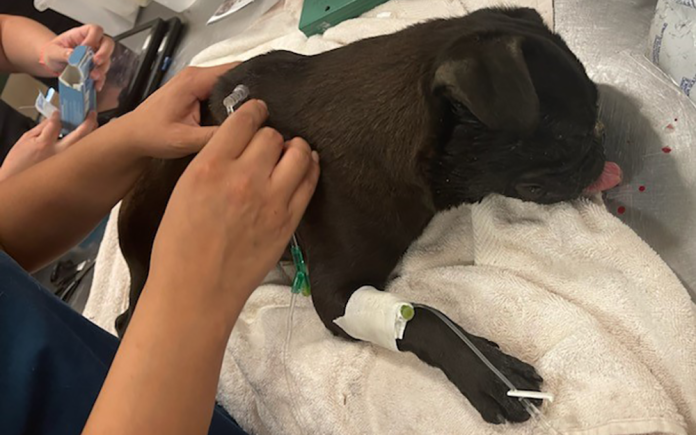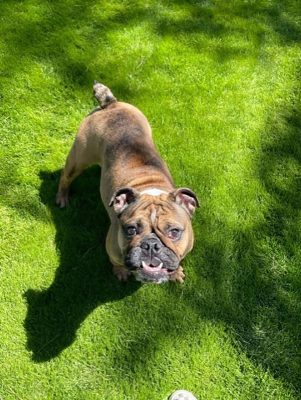
By Janet McAfee
Coachella Valley summer weather can bring distress and even death from heat stroke to our beloved dogs. Our scorching desert heat is distressing to our domestic pets and can cause permanent medical problems and even death.
In 2021, this column told the story of a precious Pug dog pictured here fighting for his life being treated by a veterinary technician at our Riverside County shelter, the Coachella Valley Animal Campus. An animal control office found him thrashing by the side of the road in rural North Shore. He was quickly transported to the shelter but not in time to prevent the seizures and painful death this dog experienced. The scorching sand raised his body temperature to a dangerous level, and he passed away shortly after this photo was taken.
The Pug was not microchipped and had no identification tag. This incident was publicized by the county’s media staff hoping that to prevent the painful suffering and death of other dogs whose owners keep their pets outdoors all day. More dogs will perish without any public attention.
This Pug’s legacy is to save the lives of more animals from the blazing summer weather. In addition to death, overheating can result in irreversible kidney, heart, liver, and brain damage. Dogs cannot sweat the way we humans do, as their only sweat glands are in their nose and on the pads of their feet.
Heat stroke is more prevalent in flat-nosed dogs. According to the AKC, French Bulldogs replaced Labrador Retrievers for the most popular breed in America in 2023. You see these cute sociable pups everywhere. These animals are more prone to Brachycephalic obstructive airway syndrome (BOAS) because their flat facial structure cause compression of the throat and nose which both result is respiratory issues.
Pictured below is Petunia, a young English Bulldog, rescued by Loving All Animals from the county shelter due to her having medical needs. Petunia loves humans but prefers to be the only dog in the home. Call 760-834-7000 for adoption information on Petunia.
Veterinarian Dr. Andrea Walters helps us understand from a medical perspective why heat stroke can be so deadly for dogs. “Heat stroke occurs when an animal’s body temperature increases so much that it cannot be regulated property and brought down. Dogs don’t sweat like people do. Heat stroke can lead to severe shock and cellular dysfunction when blood vessels near the skin dilate dangerously.”
Dr. Walters explains dogs’ need to cool through panting is why extreme heat is more dangerous to flat nosed breeds such as Pugs, Boxers, French Bull Dogs and Shih Tzu’s. While heat stroke can kill dogs of any breed, seniors and puppies are also at high risk.
More precious dogs will die from heat stroke this summer, some left in cars, others left on hot patios, some kept as “outdoor only” dogs in yards. This cannot be said enough – – – BRING YOUR DOG INDOORS DURING THIS HOT WEATHER! NEVER LEAVE A DOG UNATTENDED IN A CAR!
What should you do to protect your pup? What are the signs of heat stroke in a dog?
Take your dog on long walks in the mornings and evenings, avoiding outings when the sun is at its highest. Avoid asphalt and concrete when you walk and stick to shaded areas whenever possible. This is not the time to have him run alongside while you bicycle ride. Have a calm non- judgmental discussion with your neighbor who leaves his dogs outdoors day and night.
 The symptoms of heat stroke can include glazed eyes, heavy panting, and pulling back on the leash. Other symptoms include excessive thirst, hyperventilation, dry gums that are pale or grayish, or bright red tongue or gums. Your dog may quickly suffer weakness, staggering, confusion, vomiting, diarrhea, rectal bleeding, and ultimately collapse. His breathing will slow, and he may seizure or fall into a coma.
The symptoms of heat stroke can include glazed eyes, heavy panting, and pulling back on the leash. Other symptoms include excessive thirst, hyperventilation, dry gums that are pale or grayish, or bright red tongue or gums. Your dog may quickly suffer weakness, staggering, confusion, vomiting, diarrhea, rectal bleeding, and ultimately collapse. His breathing will slow, and he may seizure or fall into a coma.
Veterinarian Dr. Walters tells us, “If you suspect heat stroke, it is important to begin lowering the animal’s temperature as soon as possible, even before transporting them to a veterinarian. A hose can be used to cool the animal, focusing on the belly and paw pads. Be sure the water is cool, neither hot nor cold. It’s very important to not cool the animal too fast.” Lay the animal on a cool towel, but don’t wrap them in one as this could trap the heat. Seek vet care immediately.
Anyone needing additional suggestions to transition their dog from outside to inside can email me. Keep Fido safe this summer!










































